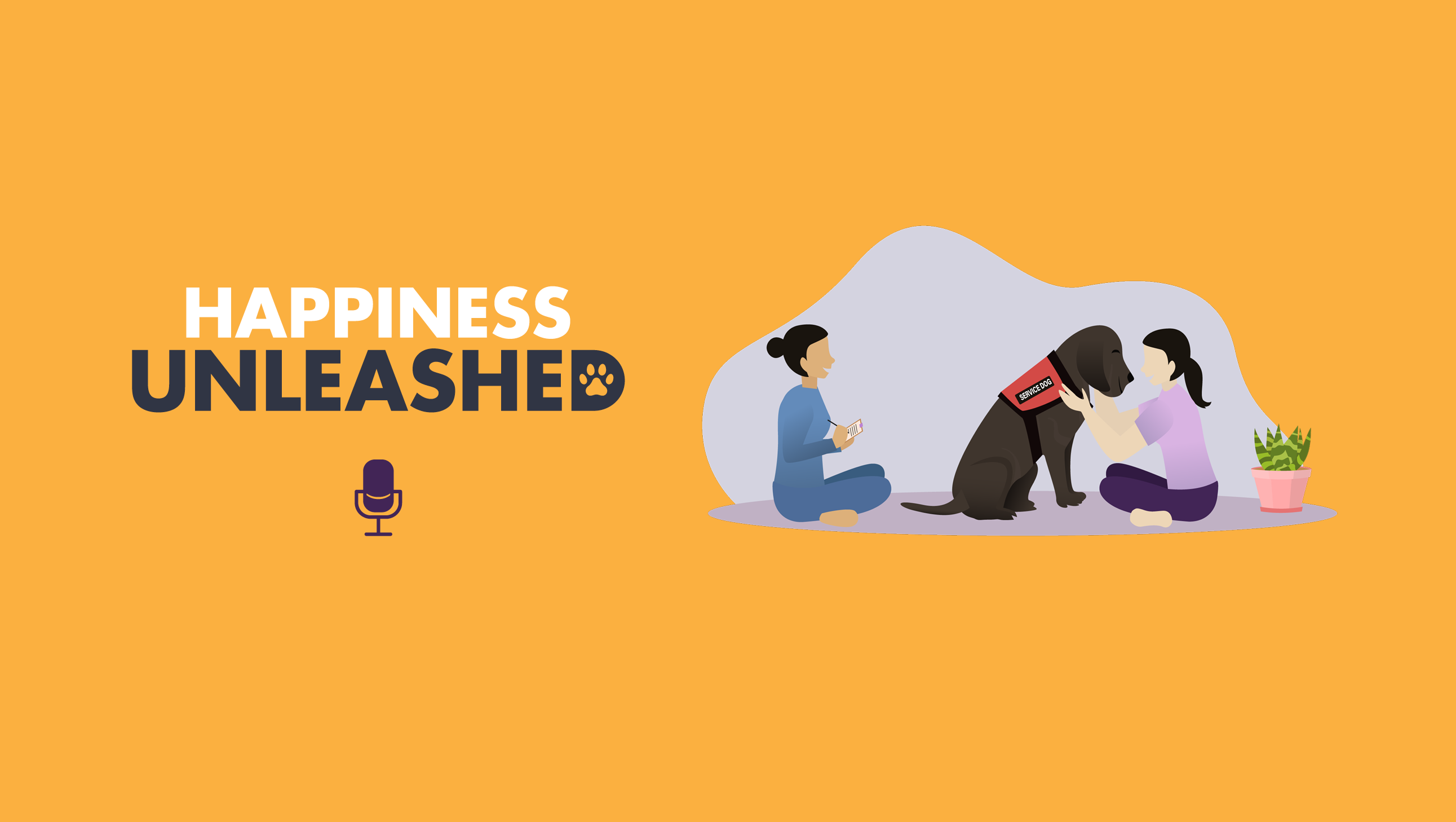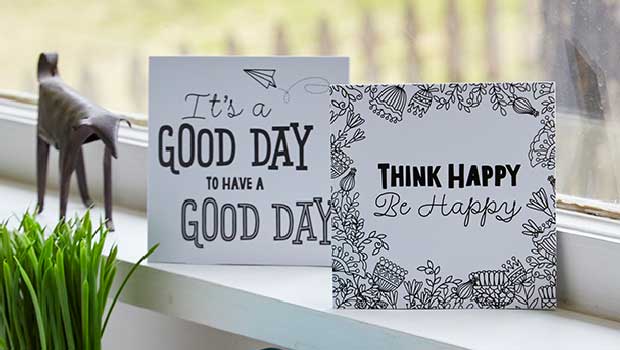Follow along with the transcript below for episode: The Secret Lives of Service Dogs With Shannon Walker
[INTRODUCTION]
[0:00:09] PF: Welcome to Happiness Unleashed with your host, Brittany Derrenbacher, presented by Live Happy. We’ve all seen service dogs in action, but most of us don’t know just what heroes they are. Today’s guest is here to tell us all about the secret lives of service dogs.
Shannon Walker is the CEO and Founder of Northwest Battle Buddies, a nonprofit providing service dogs to combat veterans with PTSD. Inspired by her father, who was a veteran, she also founded Man’s Best Friend Dog Training and has worked tirelessly to not only train service dogs, but to educate the public about what they do and how they provide a vital lifeline for veterans. Let’s have a listen.
[INTERVIEW]
[0:00:46] BD: Hi, Shannon. Welcome to Happiness Unleashed. I’m so glad you’re here today.
[0:00:50] SW: Yeah. Thank you so much for having me on the show. Super excited.
[0:00:54] BD: We’re going to talk about service dogs today, which I’m super pumped to talk about. I recently just did the keynote address at Norton Children’s Hospital and I got to meet all of the dog handler teams there. This is definitely a topic near and dear to my heart. Before we really start digging into this topic, I would just love to know just a little bit about you and what brought you into this field.
[0:01:18] SW: Great question. Thank you. Often, I don’t get to go that far back. I’ve been a dog lover. I’ve been an animal lover my entire life, and horses and dogs, but cats, anything that was on the side of the road, or even on a sidewalk, I knew needed to be saved. My dad would always be like, “No, that’s his house. He doesn’t need you to save it.” I just wanted to save everything. I’ve had dogs my entire life, and they are a staple in my life, and I don’t want to sound dramatic, but they are as much of a staple in my life as food. They bring me such joy. They center me. The gift that dogs can bring and the way they’re created and the way that they engage us is a gift that I don’t think we get anywhere else on this earth.
I’ve had dogs my whole life. I was like a lot of people, as I got older my husband that I ended up marrying was not really a dog guy. When I had a German Shepherd dog that was a little bit unruly, I loved the dog so much it didn’t bother me, but he was like, “Get him trained, or get rid of him.” I sought out a trainer, just like a lot of people do. Fast forward, I fell in love with training. I fell in love with the Schutzhund sport, which is police dog training. It’s a protection sport out of Europe.
I started doing this. I didn’t just train my dog. I competed with my dog and I took it to a whole another level. Then I got married and had twin babies and then realized I needed to make money. I thought, I knew more about dog training than I did last week and people were asking me for help when they’d seen me practice with my dog in the park. They’d ask me for help and I’d help them. I felt like I knew a lot. I didn’t know. You don’t know what you don’t know.
Anyway, but I started a dog training, a for-profit business, so I could be a stay-at-home mom with my twins. It grew. I’ve had that business now for 30 years. It’s extremely successful. I’ve trained with police dogs and all that. All breeds, all behaviors, saved a lot of dog families and just really had the opportunity and my passion, which I was introduced to my passion with my first dog that it became my purpose in life. Then, 13 years ago, I had a veteran come into my for-profit business looking for help. He wanted his personal dog to be trained to be a service dog and it introduced me to a different part of the dog world that I now am in every day, making a difference, doing my best to make a difference in the lives of our American heroes by bringing my gift and my talent, my expertise and providing service dogs to our American hero, so they can live life with freedom and independence. Yeah. I love dogs, man. I get to do this. It’s amazing. It’s amazing, what I have the opportunity to do every day.
[0:03:57] BD: Tell the listeners the name of your business.
[0:04:00] SW: My for-profit business is Man’s Best Friend. My non-profit that I started 13 years ago is Northwest Battle Buddies. I will tell you, in the last 13 years, we have provided 271 service dogs to our veterans. Yeah, it’s incredibly life changing.
[0:04:17] BD: I saw that and it is just so needed. I think that’s what fascinates me about this topic is there’s so much about this work that we don’t understand, right? I’m so guilty of this. I’m out at the grocery store, I’m at the airport, I’m just out in public and I see someone with their service dog and I immediately want to interact with this animal, right? Like, “Oh, it’s a puppy. It’s a dog.” Now, that I’m in this, where I’m supporting the dog handler teams, their mental health, the handlers, I’ve learned so much about the work that the dogs do and how to respect that and understand the boundaries and interact with it. I really want you to talk about that. What is something that most people don’t realize about the daily lives of service dogs?
[0:05:05] SW: Well, one thing, that’s another great question. One of the main things is the dog is a tool that is trained to mitigate a disability. These aren’t people’s pets that they just want to have with them in a day. They’re trying to live their life and live it better and healthier. It is their solution in part of their journey. These dogs are a tool, no different than a wheelchair, or a walker, or a cane. You’re right. Because the industry is like the Wild West and you have fake service dogs out there and you have people – calling a dog service dog doesn’t make it a service dog. But that is what society is dealing with.
People like you, whether they’re not in the industry, they’re asked to maybe understand how to navigate that, because you might have somebody with a fake service dog, or dog that is not professionally trained, or a handler that’s not professionally trained, and they’ll say, “Do you want to pet my dog?” Well, then they’re giving mixed signals to well-meaning people that don’t know, you need to ignore this dog. Back to the point of this is a tool, much like a wheelchair, somebody in a wheelchair that needs a wheelchair to do their grocery shopping. If you were to see somebody coming with a wheelchair, doing the shopping, we would actually move to the side, give them more space, smile and walk on by. That is exactly what we need to do with a service dog, but that’s not what happens to our veterans, and that’s not the experience of a lot of people who have chosen that option forward for them.
They have to listen to pet stories. They’re stopped in their daily life and they’re engaged by people, because of the tool. It can be a huge hindrance. It can be a frustration. It is what it is. The fact is, is that if people listening to this, one of the greatest takeaways is that we need to see the value in the dog as such, because they are life-saving tools. Whether it’s a dog that is alerting on high-low blood sugar for somebody that has diabetes, or whether it’s a seizure detection dog, or if that dog is trained to alert on adrenaline spikes and a panic attack. You know what I mean? It’s like, that dog is working and people, it’s not the four-legged friend at home. It’s a completely different experience, a completely different mindset.
[0:07:11] BD: I guess, what would help me and I think would help everyone listening is what classifies a working dog and a service dog? What makes them different than say, Harley, who’s behind me, who’s just an emotional support dog, hangs out on my client’s laps, what differentiates the two?
[0:07:27] SW: The training. The training. People who have a service dog have a disability. Number one, you have to have a disability and the dog has to be trained to task for disability. At Northwest Battle Buddies, our dogs go through a minimum of 360 hours of training to navigate life and learn how to task. Then our veterans go through 200 hours of training, or 160 hours of training with us five weeks on the ground, learning how to use the tool. The difference is that service dogs are trained to task for a disability to mitigate the disability, that will allow that person to be able to live life differently from what maybe would impede them from being able to thrive in their life.
An emotional support animal does not have rights, access rights. A service dog has access rights to go into public, everywhere but a sterile environment, but emotional support dogs don’t have access rights. They serve the human at home and it can bring great value, but they’re not allowed to go out. That is a big, confused area where people think, “I need my dog to feel good, so I’m going to take him out in public,” but it’s so far beyond that. It is the specific training to task for disability and service dogs have access rights that emotional support animals don’t.
Then, often, when people call me, they’ll call my for-profit business and they’ll say, “I want my dog to be a therapy dog. He’s my companion.” Well, then they would start to convolute these words, and even a therapy dog. We have therapy dogs which are trained to serve a group of people. You go to the hospital, you go to maybe an elderly community. But that dog goes in and just loves on everybody. You have the emotional support dog at home that does not have access rights in public and they’re not trained to specifically task for a disability, and then you have service dogs; they’re allowed access, they’re trained to serve a disability. They have specific hundreds of hours of training and that handler has to be trained to handle professionally, so they can use the tool to live life at its greatest value.
[0:09:34] BD: Service dogs for veterans specifically, what kind of disabilities are they supporting? How are they working on a daily basis?
[0:09:42] SW: Service dogs for veterans with some of the main things that they task for, some of them, they wake them up from nightmares. It’s amazing. When I would sit and visit with our veterans and they haven’t met their dog yet, we’ve read all of their file, because we specifically match dogs. A veteran doesn’t come pick their dog. We are starting a group of veterans in two weeks. We have 10 veterans coming in and we have 12 dogs. We look through their entire file, their health records, their mobility, their lifestyle, their work and what these dogs need to task for, and the dogs are already pre-trained to task for multiple disabilities that are common for veterans with PTSD. We specifically match these dogs.
When we’re sitting down and listening to a veteran speak and they – You have these Vietnam veterans and they just start to cry, because they haven’t slept in decades. My dad always said, there’s a price for freedom. Our veterans are still paying a price for our freedom long after they’re not wearing the uniform. Here, I have a Vietnam veteran crying, because he hasn’t slept in decades, or that’s their worst time of night, because now they’re having to relive their trauma in their sleep. They’re literally afraid to go to sleep.
Our dogs, to answer your question, what do the dogs do for our veterans? Often, they wake them up from nightmares. A lot of our veterans don’t even sleep with their wives anymore, because if their wife tries to wake them up, they come out of it violently. What’s different about the dog is it’s a different form of touch. Whereas, the human may wake, the wife may wake the veteran up from a nightmare, but it’s a familiar touch where they may come out swinging and a lot of veterans, they feel so guilty for that, but the dog is different. The dog will stand on their chest. They will nuzzle them. They will lick them. Because it’s a different sensory, they don’t come out of it violently. The dogs are trained to alert on adrenaline, which starts panic attacks and flashbacks.
They smell much like a epileptic seizure dog. They smell the adrenaline and the chemical changes in the body from stress. The dogs will start to interrupt that, even before the veterans know they’re starting to spin out. We’ve had veterans, even in interviews, when they’re being interviewed on camera and then they start to speak about a traumatic moment and they start to get upset, the dog will leave the down command and start to get in their lap, lick their hands, paw them, or even get up and start to lick their face on camera.
The veteran, sometimes he’s so caught up in the interview, he’s like, “Off, off.” I’m like, “No, he’s tasking for you.” This literally happened at a graduation. The veteran was learning how to recognize what this dog was doing. It’s a learning process. We also, our veterans, we often use the dogs as a social barrier, because crowds are a big deal. It’s about just placing that dog in a safe way that just keeps the crowd at a little bit greater distance. Those are just a couple of the things that our dogs will do, but they act as a social barrier to wake them up from nightmares. They help stop panic attacks and flashbacks. These are the most common ones that are used when veterans go out.
Then the other thing is just that the grounding technique of the dog. When the veteran starts to realize that this dog is indicating, then the veteran will start to work at grounding, touch the dog. We have one veteran, she reaches down and she puts her hand on the heartbeat of the dog and she starts to get in rhythm and her breathing and thinking. She grounds herself, gets herself. Our veterans talk about this. This is what they’ll say. They say, the mission might be to go get milk in the grocery store. We take it for granted. We can do it without thinking. But they’re doing it. They go in and they go to get the milk, they start to have a panic attack and they ground themselves. They use the dog. They refocus and then they finish the mission. Whereas before, they would have just ran out, or not even gone in the first place.
[0:13:22] BD: We’re not worthy. It’s so good. It’s the co-regulation and the down regulation. It’s such a gift that only these animals can provide, right?
[0:13:35] SW: Oh, yeah. Well, yes. The thing is, is that dogs, I tell our veterans when they come into us, you’re not responsible for what happens to you, but you are responsible for your healing. The only species that lives in the past are humans. Dogs live in the moment, and we can take great rules of life by how the dog lives their life. Our veterans, they’ve been taught to lead. They’ve been taught to be disciplined in their military service. These are courageous men and women that have sacrificed for people they will never meet. Here they are looking for help. Just the fact that they’ll even ask for help.
We tap in the service dog, this modality, this option of using a dog. A lot of our veterans come off of medications with the help – We had one veteran that was on 30 medications a day. After having his dog, he’s on one medication a day now. That is so huge. The fact is, is that, but we tap into that desire, we tap into the responsibility that is needed to be able to lead a dog successfully. Living in the moment now, everything that they have to do to lead their service dog successfully are great success, life success principles and learning how to read their dog and find. It’s like, dogs are great indicators of if they’re safe, what’s coming, their senses are greater than ours will ever be. When you learn how to read your dog and focus and pay attention, the dog will tell you what’s coming and the dog will be a great resource of peace for hyper-vigilance, for anxiety. You’re right. The dogs are an incredible gift. The more we learn about them, it’s like opening up a present of what value they can bring, no matter what we’re going through.
[BREAK]
[0:15:31] PF: We’ll be right back with more from Brittany and Shannon. Now, let’s get back to Happiness Unleashed.
[INTERVIEW CONTINUED]
[0:15:39] BD: For me, I’m seeing an animal that’s doing a trained task. But for the human that this animal is bonded with and is working for, there’s so much more there than just a trained task happening. There’s like, this soul bonds, there’s this, I mean, beautiful emotional support that’s happening for them.
[0:16:00] SW: Yeah, it’s an exchange. I tell people, no matter what we’re doing with the dog, but especially in the service dog world, when that veteran is starting to spin out, or be anxious, or is using the dog, or grounding, like the veteran that puts her hand over her, that there’s an exchange of breath, there’s an exchange of this moment that we’re getting through together. It is. When I competed in Schutzhund – I ended up being a single mom and had to raise my boys alone and all this stuff. The birth of my kids, absolutely one of the greatest moments of my life, like a lot of mothers will say. But out of the top three greatest moments of my life, standing on the podium for the first time with my dog in competition, because I had achieved something with the dog and shared something with the dog that I felt was unachievable for me. I shared that experience, and it’s an exchange.
Those are the greatest bonds is when we stop and take a moment and live in that moment and recognize, this is an exchange of two species connecting on a level that often, we can’t connect otherwise.
[0:17:04] BD: How does it feel to be living your purpose over there?
[0:17:08] SW: You know what? It’s truly a gift from God. That’s such a great question. I get to do this. It’s like, no matter what you’re doing, if you’re going to try to achieve anything great, or make a difference, there’s always the highs. It’s like, when we get a text message in the morning that, and this is a specific text message, just like, “Talon saved my life last night.” This veteran, he says, “My broken brain decided to end it.” He was literally sitting in a room with a box cutter, crying his eyes out, and the dog was relentless in getting him out of that moment. Because he had decided to take his life in the midnight hour. The fact is, is our service dogs are there when nobody else is, and this service dog interrupted it through pawing and licking and franticness, while he’s sitting on the floor.
Instead of reaching for the box cutter, the dog broke him back and brought him back to that moment. He looked at his dog’s face and saw what Talon was doing for him. Instead, he took a photo of his dog and sent it to us, and said, “Because of Talon, I’m enjoying another sunrise.” That’s the blessing. That is the fuel in our veins that keeps us going is when we know that our dogs are out doing their job and saving our veteran’s lives.
There’s always a backside to the blessing. Then, there’s running the 501c3, there’s needing donations and funds, or when we’re helping veterans that are struggling. There’s always a backside to the blessing of anything great. The fact that I get to work with dogs every day, love them and see them grow and have their own triumphs. When we’re training in a public and we teach them something that might have made them nervous or scared and then we help them through it and then we celebrate at the end, like even an escalator. We’re playing and playing tug-of-war at the end of the escalator. The dog is like, “Yay.” I mean, it’s so awesome to be able to do that every day.
I think, often, when I was a little girl, just wanting a dog so bad before we got our first dog and then how I was with my dogs growing up, I didn’t know enough to even dream for this, but I didn’t know I was going to get to live my dream. Then to be with them every day in an intimate way and to be able to make a difference is awesome. I’m so grateful to God for what I get to do.
[0:19:32] BD: Thank you so much for the work you’re doing. Oh, thank you for that.
[0:19:34] SW: Yeah, thank you.
[0:19:36] BD: I mean, I think everyone listening can really relate to that. Our animals, you spoke of the midnight hour. Our animals are always there for us in the midnight hour. I think everyone probably has a moment in their life that they can think back to where their animal is the reason that they got up in the morning, right? Or their animal is the reason that they kept moving forward, or they went out and took them for a walk and took a deep breath and recalibrated.
[0:20:05] SW: Yeah, 100%. Well, the thing is, is that a lot of the veterans that we meet, they’re just hanging on by a thread. Now granted, there’s a qualification process where they have to have a stable life enough to be able to handle the responsibility of a service dog, because we always tell our veterans, “You’re our mission, but the dogs are our responsibility.” We oversee those dogs throughout the dog’s entire life. We don’t provide these dogs and then never see them again. We see these dogs on a yearly basis. We have vet records. We have weights. There’s an accountability on the end of the gift, because these dogs cost us $25,000, but they are 100% provided free of charge to our veterans that qualify and come through our program.
A lot of our veterans, when they come into us, they don’t really value their own life, but they will quickly give their life for this dog. They will do for their dog – What I have found is veterans will do for their dog what they are unwilling to do for themselves, and they will – The very, very first veteran that I started working with, I didn’t know all this until I walked out the process with him. Kevin came in with Sammy, his personal yellow lab and he wanted her to be trained. I assessed her, because I trained service dogs before, but I just never trained a dog for PTSD. I assessed her. She was young enough, healthy enough and had temperament enough. Then it was just a matter of training.
He left her with me for many months. When it was time for Kevin to come back, I started to learn about the suicide rate among our American heroes. I learned about the last firefight that Kevin was in. He was a front gunner in the army. The last firefight he was in, the men and women that survived that firefight, six of them after coming home on American soil had committed suicide. He had been self-medicating for a year with illegal drugs. By the time he came to me, he was clean and sober and he was heavily involved in support at the VA and all this stuff.
What I saw him do, which was un anything I had experienced between the human canine bond before, is I saw Kevin be willing to go places he was unwilling to go alone. I saw him willing to go with her. I saw him be willing to do for her what he was unwilling to do for himself. Then, I’ve accomplished a lot in the dog world. I’ve competed in Europe. I’ve stood on the podium. I competed against 13 countries. I’ve worked with police dogs. I’ve helped thousands of pet families stay together. When I watched Kevin walk away with Sammy in his side after finishing training, his head was up and his shoulders were back and I significantly felt like I made the difference in my quality of somebody’s life.
Then, my simple-minded thinking, I thought, if I can just adopt dogs out of shelters, I can train them and I can gift them and say, “Thank you for my freedom,” 271 dogs ago. We don’t just use shelter dogs. Now, we also do purpose-bred dogs. The fact is, is that these veterans, they value their service dogs’ life sometimes more than their own and it comes to their purpose, what you were just speaking about. They get up in the morning, they take them for walks, they go out, they do for their dog what they are unwilling to do for themselves. They tap into that training that they came from the military with and they thrive. It just all comes together like a perfect storm.
[0:23:19] BD: I want to circle back really quick, because I didn’t realize that you would take dogs out of shelters and train them.
[0:23:25] SW: Yup. When I decided, my dad always said, you don’t know what you don’t know, along with many things. I did. I stood in my office thinking, I just thought, I just needed – adopt dogs out of shelters. I instantly contacted a local shelter. Because of my reputation at my for-profit business, they allowed me to come in. I adopted five dogs for free and left that day, because I already had a channel with professional staff and everything. I just funded it before the 501c3. I walked away with five dogs and I just got started. Yeah. I mean, it’s like, save a life to save a life.
[0:24:02] BD: Absolutely.
[0:24:03] SW: Milieu shelter dogs. We are one of the largest service dog providers for veterans in the United States. All we do is provide service dogs for veterans. That’s our niche. That’s our expertise. We also have purpose-bred dogs, because we have a lot of children. We have a lot of people in the workforce. We need some of the breed tendencies that we do for a lot of our dogs now with the English labs and the English Cream Golden Retrievers, or the Labradoodles for hypoallergenic and all that stuff. It’s really developed into a large, but we always take the rescues. Now, we don’t have to go into shelters, because people know about it, so they will offer us their dogs before they go to shelters. Then we can get at a history –
[0:24:43] BD: That’s amazing.
[0:24:45] SW: Yeah. Just in the last group, we had a dog named Honor. He ended up being the best dog. They’re all great, or they wouldn’t be service dogs. Some dogs, they just shine a little bit more and he’s just an amazing dog, serving his veteran and changing his world.
[0:25:01] BD: I wanted for a second shift a little bit, because I would love to hear your thoughts on just the future of service dogs and maybe a little bit of advocacy, right? How do you see the role of service dogs really evolving going forward? Where do you see it heading?
[0:25:16] SW: Well, more. The thing is, is that as we unleash this information, and that’s why I’m so grateful to be on your show is because people need to know, and a lot of people – my dad always said, you don’t know what you don’t know. You’ve heard me say that multiple times. It’s so true. A lot of times, people will let what they need to learn get – sometimes people will let what they know get in the way of what they need to learn. We need to open up people’s minds about the power of the dog, the gift and the value they can bring to the human world, whether it’s police work, search and rescue, companionship, ESAs, but also in the medical world.
I’m also the Executive Director of the Association of Service Dog Providers. It is an elite group of service dog providers for veterans and we bring advocacy for businesses, for restaurants, for the airline, the travel industry. We want to bring not only providing service dogs, but education. Where it needs to go, where the service dog industry needs to go and its advocacy is the acceptance that these dogs in mental health, which then leads to physical health, absolutely are an answer for so many people.
The service dog isn’t the answer for everybody and it’s not an answer for every veteran. But for the veterans that do go through the process that are living life to the fullest, it is their answer. The dogs need to be taken seriously. Northwest Battle Buddies is also part of a groundbreaking, it’s called the Wounded Warrior Service Dog Project, and it doesn’t have anything to do with the Wounded Warrior non-profit. It is something that the Department of Defense has put together when they put money towards service dogs for veterans. There’s 151 guidelines that we are a part of, tracking the tangible difference that the tool is making in the dog and it’s formed in such a way.
This is our second year. When it started, there were only 24 organizations across the United States. But this is an effort to legitimize the tool in a grand way to make service dogs more accessible to the people that need them. It’s about education. Personally, I’m involved as the executive director of ASDP, we’re involved in the Wounded Warrior Service Dog Project. I do all the podcasts, all the interviews I can to advocate for the significance that these animals are making, so they are taken seriously. On the other side of that, organizations have to conduct themselves in such a way to be taken seriously. That’s the other part of the Association of Service Dog Providers is we are creating avenues for service dog organizations to learn and come up higher. The dogs are trained more professionally, our veterans are educated on a professional with professional handling. And so, it’s not a hindrance to the public. It’s not a liability to the grocery stores when people are taking their dogs in.
There needs to be an education and vehicles created moving forward. I’m involved in all of that in the different aspects, not only to bring service dog organizations up higher, so their dogs and their veterans can be taken seriously and the tool actually is making a difference, but also that the government, that business owners that there’s an education that this is a viable, tangible tool, no different than a wheelchair cane, or walker, or prosthetic, or whatever it might be, that these dogs really are making it possible for these veterans to live.
It’s education all the way around and it takes time and it takes passion and sacrifice to do that, to change minds and to bring awareness. It’s a heavy lift. It’s a lot. Because we’re providing service dogs to our veterans. Now, they start to go out and live their life and then they get rejected when they go into stores, they get looked down on, because of the fake service dogs that the store ran into all the time. What we are always hearing, our veterans will come back and say, somebody in the store told me, or this business owner, or this doctor said, “This is the best service dog I’ve ever seen.”
The fact is, is that that’s great, but that’s what every service dog should be like. Trained, discipline, not getting in the way of people wanting to shop and live their life. It’s a tool. That dog needs to just be able to walk alongside his person, follow and do its job without abrupt behaviors, or whatever’s happening. It’s a huge question and there’s a lot of layers to the answer.
[0:30:00] BD: If you could share one simple message with the world about service dogs and how we can best interact, what would it be?
[0:30:09] SW: Professionally trained service dogs and handlers, these dogs are tools that are absolutely making the difference for some of our veterans at Northwest Battle Buddies, the difference of life and death. If you encounter anybody with a service dog, I’ve had people ask me, what should the person do if you encounter a service dog? Absolutely ignore them. Smile and walk on by. These people with service dogs are out just trying to live their life like you, and they don’t want to be stopped every day to hear your wonderful pet story, or how beautiful their dog is. They just want to be normal. They’re trying to get back to normal.
If we could respect the fact that they have courage to press on and for veterans not become the statistic of 22 veterans a day that are taking their life because they’ve given up hope. If you see a veteran with service dog, they’re fighting for their life, they’re fighting for their family and they’re fighting to try to get back to whatever might be normal, because they never will be again.
[0:31:08] BD: just respectfully, keep it moving.
[0:31:10] SW: Keep it moving. Smile and walk on by.
[0:31:13] BD: Yeah. Hold them in your heart. You can hold all that internally as you walk by. Like, “Man, that just made my day to see this dog.” It can be so inward.
[0:31:23] SW: You can appreciate it in the distance.
[0:31:25] BD: Mm-hmm. One more question for you, just out of my own curiosity, do these service dogs ever go off duty? What does relaxation look like for them?
[0:31:35] SW: Oh, yeah. Life. That’s a great question, too. When dogs are invested, they’re working. Even though, leadership and respect is always in a human-canine relationship, you know what I mean? When they are off duty, they’re running on the beach. They’re hiking in the woods. They’re playing with the kids in the backyard. The service of life is the best life, because they’re with their human every day. They have purpose. They have leadership from their human and they have the best life. Off duty is like any other well-trained pet that gets to go and live life and run and play and have relationship with other people.
[0:32:17] BD: Yeah. It’s beautiful. Thank you. This conversation has been so informative, and so important. I can’t thank you enough for coming on the show. There is a question that I ask all of my guests before they leave. It’s a tough one.
[0:32:33] SW: Okay.
[0:32:35] BD: I know you’ve had a lot of animals in your life, but is there a specific animal that has been a part of your life that has brought magic and healing and that you would like to share with us?
[0:32:47] SW: It made me cry just thinking about it. You know what? That’s like asking somebody to choose their favorite child. I do not equate dogs to my children. When I look back at my dogs, if I had to say, maybe it would be Max, the first dog I ever competed with, because my journey with Max got me introduced to Schutzhund and got me becoming a dog trainer and introduced me to what would become my passion became my purpose. It all started with Max.
Some of the greatest moments in my life were with Max, but it was the beginning of many firsts that led the way for my other dogs. When I look back at my other dogs, what is significant is when I faced my own trauma, my divorce, it was an ugly situation. Those midnight hours for me, when I was going through that season, the death of my father was a different dog in that season. The dog I have now, Valiant and Caliber, it’s a yellow lab and a shepherd, they bring joy and comfort to me in different ways. If I had to pick one, it might be Max, because Max started it all, as far as the last decades of my life.
Then, if I had to go back to my very, very first dog, Button, she was a Cockapoo. She was a dream come true. I remember sitting on the river. There was this creek and I would go down even as a young girl. Maybe I was seven, eight, nine-years-old, and I would go out on the rocks and I’d sit on a big rock with my dog as the water rush by and I would talk to God about all my problems with my dog. If I go back, maybe it’s Buttons. Yeah, there’s been a lot of dogs, and I would never get another one. Because the pain of losing them is so great. But the joy they bring is priceless. I always open my heart up for the next one. Unfortunately, they just don’t live long enough. They just don’t.
[0:34:53] BD: Thank you to all of the dogs in Shannon’s life that led her to this important work. And thank you, Shannon, for coming on the show. This has been an honor to talk about this topic with you, and just thank you so much.
[0:35:06] SW: Well, thank you. This was a different kind of interview and I really appreciated it. I love the relaxed authenticity of those questions. Thank you so much for allowing me to share my heart in a different way today.
[0:35:22] BD: Thank you.
[0:35:22] SW: Thank you.
[END OF INTERVIEW]
[0:35:24] PF: That was Brittany Derrenbacher, talking with Shannon Walker about the secret lives of service dogs. If you’d like to learn more about Shannon and the work she’s doing, check out her TEDx talk on PTSD and service dogs, or follow her on social media. Just visit our website at livehappy.com and click on this podcast link. Of course, Brittany will be back here next month to talk more about how animals bring us joy, help us heal and can be some of our best teachers. Until then, for everyone at Live Happy, this is Paula Felps, reminding you to make every day a happy one.
[END]
In this episode, you’ll learn:
- How Shannon became involved in training service dogs and what she’s learned along the way.
- The difference between therapy dogs, emotional support dogs and service dogs.
- What kinds of disabilities service dogs assist veterans with.
Check out Shannon’s TEDx talk, “PTSD and Service Dogs: Beneath the Surface”
Visit Shannon’s website.
Follow along with the transcript.
Follow Shannon on Social Media:
- Facebook: @NorthwestBattleBuddies
- Instagram: @NorthwestBattleBuddies
- YouTube: @NorthwestBattleBuddies
Follow Brittany Derrenbacher on Social Media:
- Instagram: @lunabells_moonbows
- Instagram: @sunshinehealingky
- Website: https://www.sunshinehealingky.com/
Don’t Miss a Minute of Happiness!
If you’re not subscribed to the weekly Live Happy newsletter, you’re missing out! Sign up to discover new articles and research on happiness, the latest podcast, special offers from sponsors, and even a happy song of the week. Subscribe for free today!
Interested in advertising or partnering with us? Complete this quick form.











